How to Teach a Kid to Catch With a Baseball Glove
Little League coach Mike Randazzo, whose team played in last year's World Series, shares his tried-and-true method.

If your kid is just hitting tee-ball age, it’s about time they learn the fundamentals of catching with a glove. And there’s an easier way to do it than just posting up in the yard and pelting them till you hit leather. Catching with a mitt isn’t as natural as, say, catching a basketball (stick out both hands and grab it). Which is why Fatherly called up Mike Randazzo, head coach of the Fairfield American Little League All-Star team from Fairfield, Connecticut ⏤ New England’s representative in last year’s Little League World Series ⏤ for some pointers. Randazzo’s taught hundreds of kids (including his own three sons) to catch a ball over the years and has it down to a science. Here’s what he does.
RELATED: The Best Baseball Equipment & Gear to Get Kids Ready for Little League
Start With Something Soft
Some kids are fearless, but most start with a healthy fear of a hard piece of leather beaning them in the face. This is natural but can get in the way of proper fielding. It’s best to start off slow. He recommends using a tennis ball or a soft baseball. “The first thing is to get the player to not be scared of the ball,” Randazzo says. “Invariably the player’s going to miss, so it’s nice to know that it won’t hurt.” Before donning a glove, throw a few to the child barehanded so they can get a feel for catching in general, and see that the ball won’t hurt if they get hit.
Practice Opening and Closing the Glove
Fortunately, most kids gloves come broken in ⏤ so you shouldn’t have to spend any time oiling it up. They should also open and close more easily than an adult glove, and some glove makers even going so far as to use patented technology to ensure they do. Still, before you get started, it’s important to make sure the glove fits the child’s hand and isn’t too tight or falling off. Assuming it fits comfortably, have the child practice opening and closing the mitt until they get the hand motion down. Once they do, have them hold the glove face up while you drop the ball in ⏤ that way they get the feel of the ball landing in the webbing and build confidence with each catch.
Aim High, then Aim Higher
According to Randazzo, the easiest place for a child to catch a baseball is right above their head on the glove side, so they barely have to move their mitt. After showing them where to position their hand, take a step back and start tossing the ball right at it. In the beginning, the goal is to throw soft strikes, underhanded even, so they don’t have to do much more than open, close, and control the ball.
It’s here that you also want to stress the importance of keeping their eye on the ball and following it into the glove. Watch their eyes as the ball approaches. If they consistently close them or look away, continue to assure them that there’s nothing to be afraid of. If need be, slow down the speed until you’re certain they’re following the flight of the ball all the way into the glove.
As they get more comfortable catching it, move your throws a bit higher. By putting more arc on the ball, you’re simulating what they’re going to get on a pop fly. Also remember to mix up the throws so it doesn’t get too repetitious. “Baseball is boring, it’s a lot of repetition,” Randazzo says. After they get the basics, it’s good to vary up the throws a little.
Show, Don’t Tell
Not every kid is going to pick it up right off the bat ⏤ hand-eye coordination doesn’t always come naturally. For those who are struggling to reel the ball in, Randazzo recommends getting right behind the child and physically helping them catch the ball as another person tosses it. “Get behind player and hold their hand up, rather than just dictating to them,” he says. Sounds basic but, much like holding a bat with them as they learn to swing, it helps them understand the action.
Throw the Ball, Don’t Use a Bat
After you’ve got the fundamentals down, there are some specific things you can do to further refine a player’s catching ability. Randazzo says that while a lot of coaches immediately jump on the Fungo bat when doing basic fly ball drills, that’s not necessarily the best move. He likes to throw the ball. That way he knows exactly where it’s going and how high/hard it’s coming at the kid ⏤ not everyone can be Benny the Jet and smack a fly ball right into an outstretched glove.
This article was originally published on